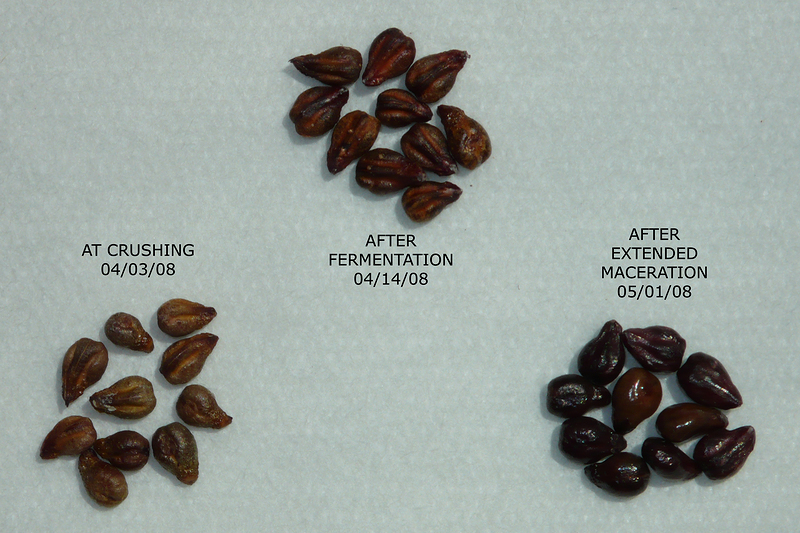My friend
Greg Snell recently posted to his
blog about "non-interventionist" winemaking and the WinePod. I will take this opportunity to weigh in on the subject.
What on
earth does someone mean when they talk about "non-interventionist winemaking"? Where did this term come from? I'm not the first person to ask these questions. Check out Eric Asimov's
piece in the NY times from October 2006. I think it may be that the term first arose in the film "
Mondovino" which, for dramatic effect, built its narrative around the differences between the "...old world and new, simple peasants and billionaires, and between the local and artisanal styles of wine production and the multinational and mass-produced ones."
Award-winning New Zealand winemaker and writer Drew Tuckwell put it as succinctly as such a vague and useless concept might possibly be clarified: "Non interventionist winemaking is
not easy to explain. There are no defined or common rules. It is essentially a very natural form of winemaking ... where, in general terms, winemakers resist the use of
modern technology and simply allow the wines to express the terroir of the vineyard."
(1) Emphasis mine.
My sainted Dallas-bred grandmother had a term for this kind of marketing-speak: "horse-puckey".
The craft of winemaking is the transformation of grapes with alchemist skill. For centuries the French have applied the terms "
elevage" and "
affinage" to the winemaking process. The winemaker facilitates the birth of the wine, and then
raises it and
refines it into something which, if not always transcendent and sublime, is at least palatable. I believe the most apt analogy for winemaking is child-rearing. I for one don't believe that child rearing can be at all non-interventionist. And neither can winemaking be.
I shall step on a slightly taller soapbox to proclaim: I believe that
ALL wines – artisanal and mass-produced alike – are valid expressions of the grape, and of the winemaker's craft. There is no way to define a cutoff between these arbitrary classifications; wines are produced along a technological contiuum.
On the other hand,
all wines are not created equal. There are distinctions between the aromas and tastes of wines made by hand and those produced by machine that are no more arbitrary or subtle than the differences between, say,
Redwood Hill Farm crottin and processed American cheese spread, or
Boont Amber Ale and Bud. But there is no doubt that the makers of the
crottin and the ale are
interventionist to a fault in crafting their products. So are ALL winemakers worthy of the title.
For contrast, let me paint a scenario of the least-interventionist winemaking I can imagine. Find some grapes – they must be wild, or escapees from cultivation, un-pruned and otherwise un-farmed. Pay no attention to the mildew, bird damage and rot. Taste them to see if they are ripe, and try to forget that professionals with decades of experience sometimes misjudge ripeness by taste. Pick them anyway.
Put these natural wonders in a garbage pail in the garage – don't worry if the pail is clean or not, or how hot or cold the space is. Intervene to the extent of crushing the grapes by foot. Step away at this point, intervention complete – the grapes will ferment. But at least go so far as to cover the pail before turning out the lights. Come back in a month or so, lift the pail and make a small hole in the bottom for the liquid to drain out. Intervene again to push on the mass inside the pail to press as much liquid out as possible. Collect, taste and savor.
I can say from personal experience that the results will not be palatable.
I can also say that there is not a capital-poor winemaker worth the title that has not wished for a centrifuge (for clarification), a spinning cone (for alcohol reduction), or for ion-exchange (to remove volatile acidity) at some point in their career. In my opinion, any winemaker that can say they are "non-interventionist" with a straight face, or at least without a little lurch of self-loathing in the pit of the stomach, is a charlatan or worse – delusional.
Given the choice between a garbage pail and the WinePod, I'll take the Pod thanks. I can make better wine in the WinePod. Doesn't make me a mass-producer – the wines are still hand-made. Just don't call me "non-interventionist".
 ProVina delivered five WinePods to my winery. The plan is for me to do comparison fermentations to test hypotheses and validate protocols.
ProVina delivered five WinePods to my winery. The plan is for me to do comparison fermentations to test hypotheses and validate protocols. 

